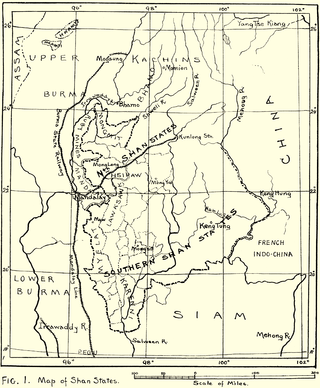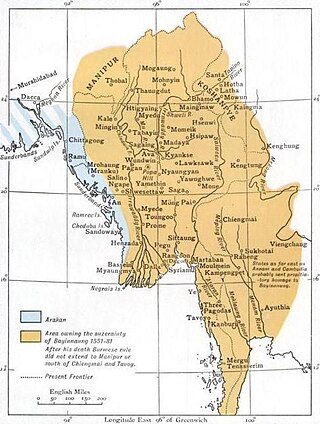
Wuntho or Waing Hso was a native state of Upper Burma when Burma (Myanmar), was under British control. It had an area of around 6,200 square kilometres (2,400 sq mi) with 150,000 inhabitants and lay midway between the Ayeyarwady River and Chindwin Rivers.

Yawnghwe, known as Nyaungshwe in Burmese, was a Shan state in what is today Myanmar. It was one of the most important of the Southern Shan States. Yawnghwe state included the Inle Lake. The administrative capital was Taunggyi, located in the northern part of the state. The Agent of the British government, the Superintendent of the Southern Shan States, resided at Taunggyi and the king's palace was at Yawnghwe.
Man Maw is a village in Bhamo Township in Bhamo District in the Kachin State of north-eastern Burma.
Momeik, also known as Mong Mit in Shan, is a town situated on the Shweli River in northern Shan State. It is the principal town of Mongmit Township, Myanmar.
Narapati I of Ava was king of Ava from 1442 to 1468. In the early years of his reign, this former viceroy of Prome (Pyay) was forced to deal with raids from the Shan State of Mogaung as well as the Ming Chinese intrusions into Avan territory (1444–1446). In the wake of renewed Chinese determination to pacify the Yunnan frontier region, Narapati was able to maintain Ava's control of northern Shan States of Kale and Mohnyin, and gained allegiance of Thibaw. However, he continued to have trouble with Toungoo which was in revolt between 1451 and 1459. One of his grandsons attempted on his life in June 1467. The king fled Ava for Prome and died there in July 1468.
Shwenankyawshin Narapati was king of Ava from 1501 to 1527. His reign saw the disintegration of the Ava Kingdom. He spent much of his reign fighting back the attacks from the Confederation of Shan States. But his efforts ultimately proved unsuccessful. The king died fighting while defending his capital from Confederation attacks, after which Ava Kingdom was taken over by the Confederation.
Sawlon of Mohnyin Tai name's Hso Lung Hpa was saopha of the Shan state of Mohnyin in the early the 16th century. He is best remembered in Burmese history as the conqueror of Ava Kingdom.

Hsipaw, also known as Thibaw, is the principal town of Hsipaw Township in Shan State, Myanmar on the banks of the Duthawadi River. It is 200 kilometres (120 mi) north-east of Mandalay.

Hsipaw, also known as Thibaw, was a Shan state in what is today Myanmar. Its capital was Hsipaw town. Hsipaw State was perhaps one of the most well known and powerful Shan States.

Mongmit or Möngmit, also known as Momeik, was a Shan state in the Northern Shan States in what is today Burma. The capital was Mongmit town. The state included the townships of Mongmit and Kodaung.

Mongnai, also known as Möngnai, Mone, Mōng Nai or Monē, was a Shan state in what is today Burma. It belonged to the Eastern Division of the Southern Shan States. Its capital was Mongnai town.

Lawksawk, also known as Yatsawk was a Shan state in what is today Burma. It was located north of Myelat and belonged to the Central Division of the Southern Shan States. Its capital was Lawksawk town. The state included 397 villages and the population was mostly Shan, but there were also Danu, Pa-O and Palaung people in the area.

Mongyang or Möngyang was a Shan state in what is today Burma. It was an outlying territory, located away from the main Shan State area in present-day Kachin State. The state existed before 1400 and after 1604. The main town was Mohnyin.

Mogaung or Möngkawng was a Shan state in what is present-day Myanmar. It was an outlying territory, located away from the main Shan State area in present-day Kachin State. The state existed until 1796. The main town was Mogaung.

The Chiefdom of Mangshi, officially Mangshi Yuyi Zhangguansi and Mangshi Anfusi was a Dai autonomous Tusi chiefdom in the west of Yunnan, China from 1443 to 1955. In 1443, the Ming dynasty established Mangshi Yuyi Zhangguansi (芒市御夷长官司) because a Mangshi chief made a contribution in Luchuan–Pingmian campaigns, and then upgraded to Mangshi Anfusi (芒市安抚司) in 1640. Chiefdom of Mangshi has an absolute dictatorship in politics, military, economy at the territory, and use the rule of primogeniture.






